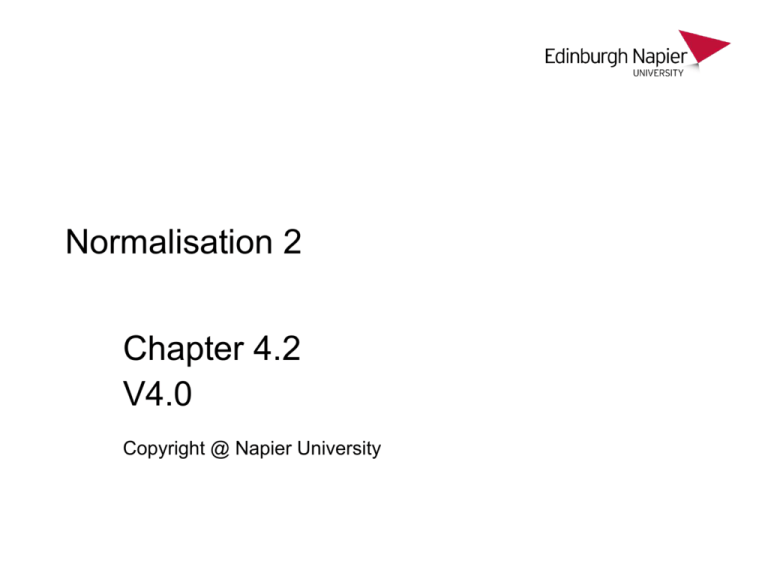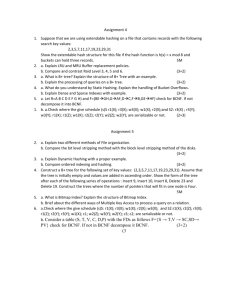Normalisation2
advertisement

Normalisation 2 Chapter 4.2 V4.0 Copyright @ Napier University Normalisation 2 • Overview – Define Boyce Codd Normal Form (BCNF) – normalise a relation to BCNF – more examples 1NF => 2NF => 3NF =>BCNF No repeating groups No partial key dependencies No transitive (non-key) dependencies Candidate Key • • • An attribute (or set of attributes) in a functional dependency (determinant) which may be chosen as the Primary key of a relation. To be a Primary key it must uniquely identify every row and must include all the attributes Some relations may have more than one candidate key e.g. R (empno, name, dob) empno => name, DOB candidate key empno name, DOB => empno candidate key name, DOB name => DOB determinant is NOT a candidate -- only 1 attrib on the RHS For any given relation, we choose one of the candidate keys to be the primary key – others, if any, are called alternate keys. DETERMINANTS Boyce-Codd Normal Form (BCNF) • • • • When a relation has more than one candidate key, anomalies may result even though the relation is in 3NF 3NF does not deal satisfactorily with the case of a relation with overlapping candidate keys i.e. composite candidate keys with at least one attribute in common. BCNF is based on the concept of the determinant. (LHS of a functional dependency) – A determinant is any attribute (simple or composite) on which some other attribute is fully functionally dependent. A relation is in BCNF if, and only if, • every determinant is a candidate key. The theory • • • Not a candidate key Consider the following relation and determinants. R(a,b,c,d) a,c -> b,d a,d -> b To be in BCNF, all valid determinants must be candidate keys. In the relation R, for a,c->b,d all of the non-key attributes can be determined, so the first determinant a,c is fine. a,d ->b suggests that a,d can be the primary key, which would determine b. However this would not determine c. This is not a candidate key, and thus R is not in BCNF. Example 1 Patient No Patient Name Appointment No. Time Doctor 1 John 0 09:00 Zorro 2 Kerr 0 09:00 Killer 3 Adam 1 10:00 Zorro 4 Robert 0 13:00 Killer 5 Zane 1 14:00 Zorro Two possible keys • • DB (Patno, PatName, appNo, time, doctor) Determinants: – Patno -> PatName – Patno,appNo -> Time,doctor – Time -> appNo • We have two options for 1NF primary key selection: – DB (Patno, PatName, appNo, time, doctor) (example 1a) – DB (Patno, PatName, appNo, Time, doctor) (example 1b) Partial key Example 1a • DB (Patno,PatName,appNo,time,doctor) – No repeating groups, so in 1NF • 2NF – eliminate partial key dependencies (PKDs): – DB (Patno, appNo, time,doctor) – R1 (Patno, PatName) [from Patno -> PatName] • 3NF – no transitive dependencies so in 3NF • Now try BCNF. BCNF Every determinant is a candidate key DB(Patno,appNo,time,doctor) R1(Patno,PatName) • Is every determinant a candidate key? – Patno -> PatName 1. DB relation: Patno (LHS) is present but PatName (RHS) is not, so not relevant to DB 2. R1 Relation: Patno is the key to R1 so Patno is a candidate key. As it is the only determinant, every determinant IS a candidate key, and R1 is in BCNF Continued… DB(Patno,appNo,time,doctor) – Patno,appNo -> Time,doctor All LHS and RHS present so relevant. Is this a candidate key? Patno,appNo IS the key, so this is a candidate key. – Time -> appNo Both Time and appNo, are present in DB so relevant. Is this a candidate key? NO. Time does not determine all attributes, so DB is not in BCNF. => Fix => Fix: Decompose to BCNF • • • • (another example) MatricNo would substitute for StudName in Napier’s database because MatricNo => StudName DB(Patno,appNo,time,doctor) R1(Patno,PatName) BCNF: rewrite to DB(Patno,time,doctor) R1(Patno,PatName) R2(time,appNo) from Time -> appNo time is enough to work out the appointment number of a patient. Now BCNF is satisfied, and the final relations shown are in BCNF Time -> appNo so Time has substituted for appNo in the composite key of DB. DB (Patno, appNo, time, doctor) => R2 (time, appNo) DB (Patno, appNo, doctor) DB (Patno, time, doctor) substitute from Time -> appNo TIME APPNO 09:00 Zorro 09:00 0 0 09:00 Killer 10:00 1 3 1 10:00 Zorro 11:00 2 4 0 13:00 Killer 13:00 0 5 1 14:00 Zorro 14:00 1 15:00 2 16:00 3 PatNo AppNo Time 1 0 2 Doctor Example 1b a different approach – same result • DB (Patno, PatName, appNo, time, doctor) • No repeating groups, so already in 1NF • 2NF – eliminate partial key dependencies: – DB(Patno,time,doctor) – R1(Patno,PatName) [from Patno -> PatName] – R2(time,appNo) [from Time -> appNo] • 3NF – no transitive dependencies so in 3NF • Now try BCNF. BCNF Every determinant is a candidate key • • DB(Patno,time,doctor) R1(Patno,PatName) R2(time,appNo) Is each determinant a candidate key (DB relation)? 1. Patno -> PatName Patno is present in DB, but not PatName. Not relevant. 2. Patno,appNo -> Time,doctor Not all of LHS present (appNo) so Not relevant 3. Time -> appNo Time is present, but not appNo, so Not relevant. Relations are already in BCNF. Every determinant is a candidate key Summary - Example 1 This example has demonstrated three things: • BCNF is stronger than 3NF, relations that are in 3NF are not necessarily in BCNF • there are several routes to take to arrive at the same set of relations in BCNF. – Unfortunately there are no rules as to which route will be the easiest one to take. Example 2 Grade_report (StudNo,StudName,(Major, Adviser, (CourseNo,Ctitle,InstrucName,InstructLocn,Grade))) • Functional dependencies – StudNo -> StudName – CourseNo -> Ctitle, InstrucName – InstrucName -> InstrucLocn – StudNo , Major, CourseNo-> Grade – StudNo, Major -> Advisor – Advisor -> Major Example 2 cont... • Unnormalised Grade_report (StudNo, StudName,(Major, Advisor, (CourseNo,Ctitle,InstrucName,InstructLocn,Grade))) • 1NF Remove repeating groups – Student (StudNo, StudName) [studno => studname] – StudMajor (StudNo, Major, Advisor) [studno, major => advisor] – StudCourse (StudNo, Major, CourseNo, Ctitle, InstrucName, InstructLocn, Grade) [studno, major, courseno => grade] Example 2 cont... • 1NF Student (StudNo,StudName) StudMajor (StudNo,Major,Advisor) StudCourse (StudNo,Major,CourseNo,Ctitle,InstrucName, InstructLocn,Grade) [CourseNo => Ctitle, InstrucName ] • 2NF Remove partial key dependencies Student (StudNo, StudName) StudMajor (StudNo, Major, Advisor) StudCourse (StudNo, Major, CourseNo, Grade) Course (CourseNo, Ctitle, InstrucName, InstructLocn) InstrucName -> InstrucLocn Example 2 cont... • 2NF Student (StudNo,StudName) StudMajor (StudNo,Major,Advisor) StudCourse (StudNo,Major,CourseNo,Grade) Course (CourseNo, Ctitle, InstrucName, InstructLocn) [ InstructName -> InstructLocn ] • 3NF Remove transitive dependencies Student (StudNo,StudName) StudMajor (StudNo,Major,Advisor) StudCourse (StudNo,Major,CourseNo,Grade) Course (CourseNo, Ctitle, InstrucName) Instructor (InstructName, InstructLocn) Example 2 BCNF • Advisor BCNF Every determinant must be a candidate key cannot be the – Student : only determinant is StudNo key for the – StudCourse: only determinant is whole StudNo, Major, CourseNo relation – Course: only determinant is CourseNo – Instructor: only determinant is InstrucName – StudMajor: the determinants are • StudNo,Major [StudNo, Major -> advisor] • Advisor [Advisor -> Major] Only StudNo,Major is a candidate key. I.e. StudMajor (StudNo,Major,Advisor) Example 2: BCNF • BCNF remove non-candidate determinants • Student (StudNo,StudName) StudCourse (StudNo,Major,CourseNo,Grade) Course (CourseNo,Ctitle,InstrucName) Instructor (InstructName,InstructLocn) StudMajor (StudNo,Major,Advisor) Advisor -> Major • StudMajor (StudNo, Advisor) Advisor (Advisor, Major) Because Advisor determines Major Problems that BCNF overcomes StudMajor (StudNo,Major,Advisor) STUDENT • • MAJOR ADVISOR 123 PHYSICS EINSTEIN 123 MUSIC MOZART 456 BIOLOGY DARWIN 789 PHYSICS BOHR 999 PHYSICS EINSTEIN If the record for student 456 is deleted we lose not only information on student 456 but also the fact that DARWIN advises in BIOLOGY we cannot record the fact that WATSON can advise on COMPUTING until we have a student majoring in COMPUTING to whom we can assign WATSON as an advisor. Split into two tables In BCNF we get two tables: StudMajor (StudNo, Advisor) & Advisor (Advisor, Major) StudNo ADVISOR ADVISOR MAJOR EINSTEIN PHYSICS MOZART MOZART MUSIC 456 DARWIN DARWIN BIOLOGY 789 BOHR BOHR PHYSICS 999 EINSTEIN 123 EINSTEIN 123 WATSON | COMPUTING Now we can delete 456 and or add Watson advising Computing Returning to the ER Model • Now that we have reached the end of the normalisation process, you must go back and compare the resulting relations with the original ER model – You may need to alter it to take account of the changes that have occurred during the normalisation process – Your ER diagram should always be a perfect reflection of the model you are going to implement in the database, so keep it up to date! – The changes required depends on how good the ER model was at first! Video Library Example • • • A video library allows customers to borrow videos. Assume that there is only 1 of each video. We are told that: video (title, director, serial) customer (name, addr, memberno) hire (memberno, serial, date) title -> director, serial serial -> title serial -> director name, addr -> memberno memberno -> name, addr serial, date -> memberno What NF is this? • No repeating groups therefore at least 1NF • 2NF – A Composite key exists: hire(memberno, serial, date) – Can memberno be found using just serial or just date ? – NO, therefore the relations are already in 2NF (i.e., no PKD possible). • 3NF? Test for 3NF • video(title, director, serial) – Title -> director, serial – Serial -> director • Director can be derived using serial, and serial and director are both non keys, so therefore this is a transitive or non-key dependency. • Rewrite video… Rewrite for 3NF • Video (title, director, serial) – Title -> director, serial – Serial -> director • Becomes: • Video (title, serial) • Serial (serial, director) Check BCNF • Is every determinant a candidate key? • Video (title, serial) - Determinants are: – title -> director,serial Candidate key – serial -> title Candidate key – Video is in BCNF • Serial (serial, director) Determinants are: – serial -> director Candidate key – Serial is in BCNF • • Customer (name, addr, memberno) Determinants are: – name, addr -> memberno Candidate key – memberno -> name, addr Candidate key – Customer is in BCNF Hire (memberno, serial, date) Determinants are: – serial, date -> memberno Candidate key – Hire is in BCNF Therefore the relations are also now in BCNF. • END •








